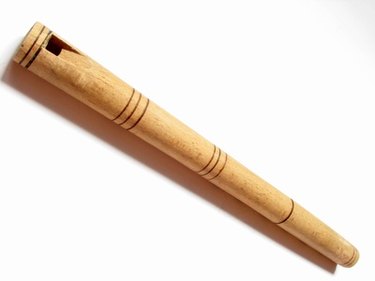Things You'll Need
Pencil
Paper
Ruler
Dense timber, such as blackwood or boxwood, 1 1/2 inches square
Saw
Wood lathe
Drill
Reamer
Linseed oil
Cotton gauze
Thin wooden dowel
Epoxy
Sandpaper

Making your own flute adds another dimension to playing the instrument. It's not uncommon for musicians to develop a deep attachment for the specific instruments they play, and crafting your own by hand makes your instrument all the more special and personalized. Wooden flutes are relatively simple instruments to attempt at home. Start with a careful and detailed plan to ensure your flute fits your hands and that each note sounds true.
Step 1
Design your flute on paper to make a plan. Determine the dimensions of the flute. Flutes vary in length, but a good rule of thumb for a flute custom made for you is to make it as long as your forearm from elbow to fingertips. Sketch two end pieces for the flute as well, and allow for these pieces within the overall length of the flute.
Video of the Day
Step 2
Calculate the location for the finger holes. One method is to measure the width of one fist along the body of the flute, past the mouth-piece, then space the first two holes so that the distance between each hole is equal to the space between the first and second knuckles. Measure the width of your fist again, then mark the location of three more holes, spaced apart at a distance equal to the space between the first and second knuckles.
Step 3
Cut the timber to length into three pieces: the two end pieces and the body of the flute. Turn the dense timber into a cylinder on the wood lathe.
Step 4
Bore into the center of the flute with a drill. Ream out the hole bored into the center with a reamer, a scraping tool made from drill-quality steel rods. Turn the steel to the desired shape of the bore on a lathe, and cut the bar lengthwise to a D-shaped cross-section. Set the reamer into the lathe at low speed and use it to turn the inside of the flute.
Step 5
Repeat the turning and boring process for the end-pieces of the flutes. Turn or finish the end-pieces to their desired shape; you may want them to fit over the body of the flute like a band, or flare out a little at one end for decorative purposes.
Step 6
Waterproof the inside of the flute with a coat of FDA-approved linseed oil. Fashion a long-handled swab with lengths of cotton gauze wrapped around a long dowel thin enough to fit through the center of the flute. Coat the insides thoroughly with the oil.
Step 7
Mark the locations of the tone-holes onto the body of the flute, using the plan you designed as a reference. Drill the holes, ensuring your fingertips can fully cover each hole.
Step 8
Fit the end pieces onto the body of the flute and secure them into place with epoxy.
Step 9
Sand the outside of the flute until smooth. If desired, apply a coat of linseed oil to the outside of the flute.
Video of the Day